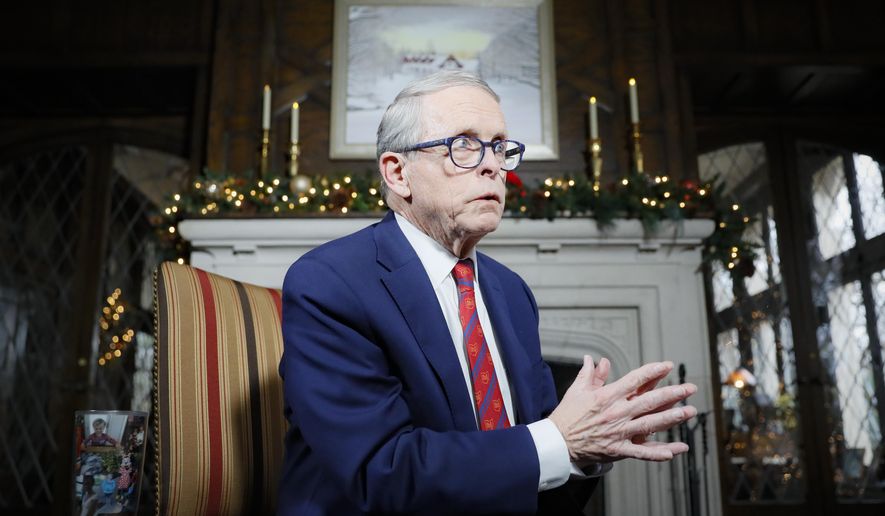COLUMBUS, Ohio (AP) -
A day after a statewide address, Gov. Mike DeWine reiterated that he does not want to shut down Ohio amid a third coronavirus wave but will have to if residents do not obey mask orders and continue to congregate in large groups.
“This is within our control. We don’t have to let it get that bad,” the Republican governor said during his Thursday briefing. “We don’t have to let it get to the point where hospitals are full. We all have it in our power to prevent this.”
Experience has taught DeWine the economic and political pitfalls of a shutdown. Ohio saw skyrocketing unemployment in the spring, followed by mass protests at the Statehouse and a number of lawsuits attempting to limit the powers of DeWine and his health director Dr. Amy Acton, who eventually resigned after severe public scrutiny.
On Wednesday night, DeWine addressed the state following record-high numbers of COVID-19 cases in recent weeks. DeWine and Lt. Gov Jon Husted have repeatedly pleaded with Ohioans to take personal responsibility for the virus’ continuous spread throughout the state’s 88 counties by doing a better job wearing masks and avoiding large gatherings.
With concerns that approach isn’t working, DeWine warned he could go a step further by once again shutting down bars, restaurants and fitness centers - businesses that he and health officials have previously noted are not the source of major community spread.
Instead, officials have said, the spread is coming from private gatherings, including parties, weddings and funerals. DeWine reissued an order Wednesday limiting public and private gatherings to 10 people.
“What you do in your private lives affects everyone,” DeWine said.
DeWine also announced the state would take over monitoring businesses’ compliance with the statewide mask order. Agents with the state insurance fund for injured workers will oversee the inspections, rather than county health boards. Stephanie McCloud, the new Ohio Health Department director, was the administrator of the Bureau of Workers’ Compensation until last week.
Under the inspection order, all businesses must display signs requiring masks and are responsible for ensuring customers and employees wear them. One violation would result in a written warning and a second in closure of a store for up to 24 hours.
DeWine’s crackdown could be particularly felt in rural counties, where some businesses have not only ignored the statewide mask mandate, but also displayed no-masks-required signs. Republicans representing those areas in the Statehouse have signaled their constituents’ feelings about mask-wearing, with most refusing to wear facial coverings during floor sessions.
All but two of the 25 Ohio counties that have seen the most new cases per capita in the past two weeks are rural, according to data collected by the Johns Hopkins University Center for Systems Science and Engineering.
DeWine’s warnings angered the Ohio Restaurant Association, which said it disagreed with studies that used prediction modeling to conclude restaurants are a significant source of spread. The agency said another shutdown would devastate the industry.
The association noted that on Monday, Dr. Andrew Thomas, the chief clinical officer at Ohio State University and a top coronavirus adviser to DeWine, said that “a second stay-at-home order that would close businesses and manufacturing is not necessary at this moment.”
About seven in 10 Ohio voters approve of how DeWine has handled the coronavirus pandemic, according to AP VoteCast, a survey of more than 3,900 voters in the state. Only about a quarter disapprove.
Similar majorities of both Republicans and Democrats think DeWine has done a good job with the public health crisis, the survey showed.
By comparison, about half of Ohio voters approve and roughly as many disapprove of the way President Donald Trump has handled the pandemic. Republicans overwhelmingly approve of Trump on the pandemic - about eight in 10 do - and roughly nine in 10 Democrats disapprove.
The top House Democrat said DeWine’s speech didn’t go far enough given the increases in cases and hospitalizations.
“Instead we just got another stern admonishing, a rehash of how dire the numbers are in our state and what appears to be a final warning that he may take steps to slow this down in a week,” said Minority Leader Emilia Sykes, an Akron Democrat.
One in every 315 people in Ohio tested positive for the virus in the past week, according to an Associated Press analysis of data provided by The COVID Tracking Project.
Over the past two weeks, the rolling average number of daily new cases has increased by more than 114%, reaching an all-time high Thursday of 7,101.
___
Associated Press writers John Seewer in Toledo and Julie Carr Smyth, Kantele Franko and Andrew Welsh-Huggins in Columbus contributed to this report. Farnoush Amiri is a corps member for the Associated Press/Report for America Statehouse News Initiative. Report for America is a nonprofit national service program that places journalists in local newsrooms to report on undercovered issues.




Please read our comment policy before commenting.